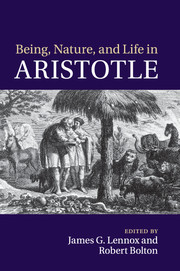Book contents
- Frontmatter
- Contents
- Preface
- Notes on contributors
- Acknowledgments
- Allan Gotthelf: a biographical sketch
- Note on abbreviations
- Introduction
- 1 Teleology, Aristotelian and Platonic
- 2 Biology and metaphysics in Aristotle
- 3 The unity and purpose of On the Parts of Animals 1
- 4 An Aristotelian puzzle about definition: Metaphysics Ζ.12
- 5 Unity of definition in Metaphysics Η.6 and Ζ.12
- 6 Definition in Aristotle's Posterior Analytics
- 7 Male and female in Aristotle's Generation of Animals
- 8 Metaphysics Θ.7 and 8: Some issues concerning actuality and potentiality
- 9 Where is the activity?
- 10 Political community and the highest good
- Allan Gotthelf's contributions to classical philosophy
- References
- Index locorum
- General index
7 - Male and female in Aristotle's Generation of Animals
Published online by Cambridge University Press: 06 December 2010
- Frontmatter
- Contents
- Preface
- Notes on contributors
- Acknowledgments
- Allan Gotthelf: a biographical sketch
- Note on abbreviations
- Introduction
- 1 Teleology, Aristotelian and Platonic
- 2 Biology and metaphysics in Aristotle
- 3 The unity and purpose of On the Parts of Animals 1
- 4 An Aristotelian puzzle about definition: Metaphysics Ζ.12
- 5 Unity of definition in Metaphysics Η.6 and Ζ.12
- 6 Definition in Aristotle's Posterior Analytics
- 7 Male and female in Aristotle's Generation of Animals
- 8 Metaphysics Θ.7 and 8: Some issues concerning actuality and potentiality
- 9 Where is the activity?
- 10 Political community and the highest good
- Allan Gotthelf's contributions to classical philosophy
- References
- Index locorum
- General index
Summary
So God created the human in his image, in the image of God he created him, male and female he created them.
(Genesis, 1.27)Urge and urge and urge,
Always the procreant urge of the world.
Out of the dimness opposite equals advance, always substance and increase, always sex,
Always a knit of identity, always distinction, always a breed of life.
(Walt Whitman, Song of Myself, 3)Why is it that one animal is male and another female? This question, addressed by Aristotle throughout his treatise On the Generation of Animals, does not mean merely to inquire into the process by which a particular animal is determined to be one sex rather than another; that question, to which he turns late in his treatise, presupposes the larger and more radical question of why animals should be sexed in the first place. Aristotle provides the broad outline of an answer to this question early in his treatise: in animals that are sexually dimorphic, the male and the female are, he says, the archai geneseōs – the principles of generation, and specifically of animal reproduction, that is, generation of animals of the same kind.
Animal reproduction, the generation by animals of others of the same kind – anthrōpos anthrōpon gennōn, for example, to paraphrase slightly Aristotle's description in the Metaphysics: human begetting human (Metaph. Ζ.7.1032a25) – is a good thing for animals, given that living is a good thing but that animals are mortal.
- Type
- Chapter
- Information
- Being, Nature, and Life in AristotleEssays in Honor of Allan Gotthelf, pp. 147 - 167Publisher: Cambridge University PressPrint publication year: 2010
- 5
- Cited by



